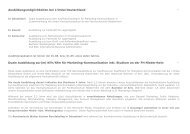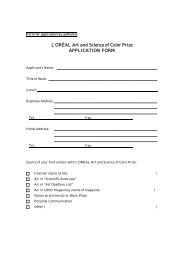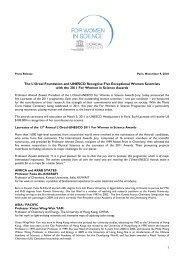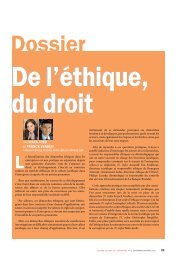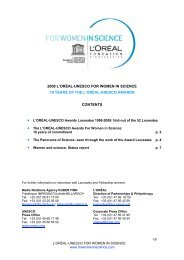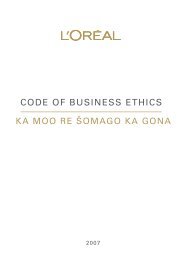CONTENTS - L'Oréal
CONTENTS - L'Oréal
CONTENTS - L'Oréal
You also want an ePaper? Increase the reach of your titles
YUMPU automatically turns print PDFs into web optimized ePapers that Google loves.
L’ORÉAL-UNESCO FOR WOMEN IN SCIENCE 2005<br />
L’ORÉAL-UNESCO AWARDS 2005: The Laureates<br />
however, than thermally excited waves, and the detection<br />
and measurement of elasticity and viscosity are thus<br />
more precise.<br />
3) USING DROPS AS A MEASURING TOOL<br />
Through a phenomenon of expansion and retraction<br />
caused by a small motor, one can create superficial<br />
compression waves of very fine drops formed at the tip of<br />
a syringe. The measurement of these viscoelastic<br />
parameters thus becomes possible.<br />
Other optical methods are currently being developed in<br />
Dominique Langevin’s laboratory to measure the<br />
thickness of the interface (an average of 2 nanometers):<br />
ellipsometry, x-ray reflectivity, and Brewster angle<br />
microscopy.<br />
A major discovery: the amazing properties of<br />
micro-emulsions<br />
Attempting to stabilize an emulsion for as long as<br />
possible, or to lower the superficial tension in order to<br />
improve their “detergent” power are primordial scientific<br />
challenges. It is possible to obtain extremely fine<br />
emulsions, called micro-emulsions, which are stable<br />
indefinitely. These fine emulsions have the power (by<br />
playing on the “resistance” of the interface - the<br />
superficial tension) to penetrate porous media.<br />
Petroleum can thus be retrieved from rocks or sand. One<br />
of the consequences of Dominique Langevin’s research<br />
has been discovering the origin of the low superficial<br />
tensions within such systems (10,000 to 100,000 times<br />
lower than those at the initial water-oil interface).<br />
Recent studies in her laboratory have focused on the<br />
characteristics of solutions containing blends of<br />
surfactants and polymers that are more or less flexible,<br />
like DNA strands that can be used in certain gene therapy<br />
approaches.<br />
The universe of foams<br />
As Aesop said about the tongue, foam is both the best and<br />
the worst of things. Foam is essential for shampoos to<br />
effectively eliminate the oils on the hair surface, but too<br />
much foam ruins the dishwashing soap.<br />
The structure of foam<br />
Upon close examination, foams turn out to be a complex<br />
group of bubbles separated by a liquid film: foams are<br />
gas inside a liquid. From the time they are formed to the<br />
time they disappear, several mechanisms govern the<br />
lives of bubbles: maturation (when gas goes from small<br />
drops toward larger drops), the drainage of liquid<br />
between the walls of the bubbles that dries out the foam,<br />
and when the bubbles burst.<br />
The study of foams draws on a number of disciplines. In<br />
the 19th century, the Belgian mathematician Joseph<br />
Plateau set out the rules governing the shape of bubbles<br />
and the number of faces and the angles between the<br />
faces. As is often the case in physics, the problem was<br />
simplified to determine its essential characteristics, and<br />
foams were initially studied in two dimensions, with<br />
bubbles being polygons. The three sides of a bubble<br />
begin at the apex of such a polygon, each side of which is<br />
at an angle of 120 degrees to the next; bubbles with up to<br />
six sides are under excess pressure and empty into<br />
bubbles with a smaller number of sides. These<br />
pressure-equalizing phenomena within a changing



